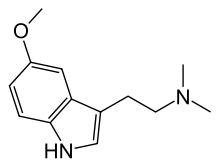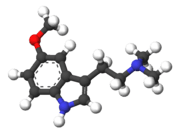5-MeO-DMT
5-MeO-DMT (5-methoxy-N,N-dimethyltryptamine) is a psychedelic of the tryptamine class. It is found in a wide variety of plant species, and at least one toad species, the Sonora Desert toad. Like its close relatives DMT and bufotenin (5-HO-DMT), it has been used as an entheogen in South America.[1] Slang terms include Five-methoxy, The power, and Toad venom.[2]
 | |
 | |
| Clinical data | |
|---|---|
| Routes of administration | Smoked, Insufflated, Oral |
| Legal status | |
| Legal status |
|
| Identifiers | |
| |
| CAS Number | |
| PubChem CID | |
| IUPHAR/BPS | |
| ChemSpider | |
| UNII | |
| KEGG | |
| ChEBI | |
| ChEMBL | |
| CompTox Dashboard (EPA) | |
| ECHA InfoCard | 100.012.558 |
| Chemical and physical data | |
| Formula | C13H18N2O |
| Molar mass | 218.300 g·mol−1 |
| 3D model (JSmol) | |
| |
| |
| | |
Chemistry
5-MeO-DMT was first synthesized in 1936, and in 1959 it was isolated as one of the psychoactive ingredients of Anadenanthera peregrina seeds used in preparing Yopo snuff. It was once believed to be a major component of the psychoactive effects of the snuff, although this has recently been shown to be unlikely, due to the limited or sometimes even non-existent quantity contained within the seeds, which instead achieve their psychoactivity from the O-demethylated metabolite of 5-MeO-DMT, bufotenin.[3][4] It is metabolized mainly by CYP2D6.[4]
Uses
It may have anti anxiety and anti depressant effects.[5][6]
Religious use
The Church of the Tree of Life, founded in California in 1971 by John Mann but now defunct, declared the use of 5-MeO-DMT to be a sacrament. From approximately 1971 to the late 1980s, 5-MeO-DMT was discreetly available to its members.[7][8] Between 1970 and 1990 smoking of 5-MeO-DMT on parsley was probably one of the two most common forms of ingestion in the United States.[8]
Pharmacology
5-MeO-DMT is a methoxylated derivative of DMT. Based on studies in rats, its pharmacological activity is believed to be mainly through serotonin receptors. Specifically, it shows high affinity for the 5-HT2 and 5-HT1A subtypes.[9] Additional mechanisms of action such as inhibition of monoamine reuptake may be involved also.[10] A 2019 European study with 42 volunteers showed that a single inhalation produced sustained enhancement of satisfaction with life, and easing of anxiety, depression, and post-traumatic stress disorder (PTSD).[11]
Sources
| Family | Plants |
|---|---|
| Rutaceae | Dictyoloma incanescens,[12] Limonia acidissima,[13] Melicope leptococca[14] |
| Fabaceae | Anadenanthera peregrina,[15] Acacia auriculiformis,[15] Acacia Victoriae,[15] Desmodium gangeticum,[15] Lespedeza bicolor,[14][13] Mimosa pudica,[15] Mucuna Pruriens,[13][14] Phyllodium pulchellum[13][14] |
| Poaceae | Phalaris tuberosa[15] |
| Malpighiaceae | Banisteriopsis caapi,[15] Diplopterys cabrerana[16] |
| Cactaceae | Echinocereus salm-dyckianus,[13] Echinocereus triglochidiatus[13] |
| Myristicaceae | Horsfieldia superba,[13] Iryanthera macrophylla,[13] Osteophloeum platyspermum,[16] Virola theiodora,[13] Virola calophylla,[16] Virola multinervia,[16] Virola peruviana,[16] Virola rufula,[16] Virola venosa[16] |
| Family | Animals |
|---|---|
| Hominidae | Homo sapiens [14] |
| Bufonidae | Bufo alvarius [17][11][14] |
| Family | Fungi |
|---|---|
| Agaricacea | Amanita citrina,[16] Amanita porphyria[16] |
Legal status
China
As of October 2015, 5-MeO-DMT is a controlled substance in China.[18]
Australia
As a structural analog of N,N-dimethyltryptamine (DMT), 5-MeO-DMT is a Schedule 9 prohibited substance under the Poisons Standard.[19]
Sweden
Sveriges riksdags health ministry Statens folkhälsoinstitut classified 5-MeO-DMT, listed as 5-metoxi-N,N-dimetyltryptamin (5-MeO-DMT) in their regulation SFS 2004:696, as "health hazard" under the act Lagen om förbud mot vissa hälsofarliga varor (translated Act on the Prohibition of Certain Goods Dangerous to Health) in October 2004, making it illegal to sell or possess.[20]
United States
5-MeO-DMT was made a Schedule I controlled substance in January 2011.[22]
See also
- 4-MeO-DMT
- 5-MeO-AMT
- 5-MeO-DIPT
- 5-EtO-DMT
- Dimemebfe
- List of entheogens
References
- Araújo AM, Carvalho F, Bastos M, Guedes de Pinho P, Carvalho M (August 2015). "The hallucinogenic world of tryptamines: an updated review". Archives of Toxicology. 89 (8): 1151–73. doi:10.1007/s00204-015-1513-x. PMID 25877327.
- "Ultimate Guide to 5-MeO-DMT - Experience, Benefits, & Side Effects".
- Ott J (July–September 2001). "Pharmañopo-psychonautics: human intranasal, sublingual, intrarectal, pulmonary and oral pharmacology of bufotenine". Journal of Psychoactive Drugs. 33 (3): 273–81. doi:10.1080/02791072.2001.10400574. PMID 11718320.
- Shen HW, Jiang XL, Winter JC, Yu AM (October 2010). "Psychedelic 5-methoxy-N,N-dimethyltryptamine: metabolism, pharmacokinetics, drug interactions, and pharmacological actions". Current Drug Metabolism. 11 (8): 659–66. doi:10.2174/138920010794233495. PMC 3028383. PMID 20942780.
- Davis, Alan K.; So, Sara; Lancelotta, Rafael; Barsuglia, Joseph P.; Griffiths, Roland R. (March 2019). "5-methoxy-N,N-dimethyltryptamine (5-MeO-DMT) used in a naturalistic group setting is associated with unintended improvements in depression and anxiety". The American Journal of Drug and Alcohol Abuse. 45 (2): 161–169. doi:10.1080/00952990.2018.1545024. PMID 30822141.
- Davis, Alan K; Barsuglia, Joseph P; Lancelotta, Rafael; Grant, Robert M; Renn, Elise (30 April 2018). "The epidemiology of 5-methoxy-N, N-dimethyltryptamine (5-MeO-DMT) use: Benefits, consequences, patterns of use, subjective effects, and reasons for consumption". Journal of Psychopharmacology. 32 (7): 779–792. doi:10.1177/0269881118769063. PMID 29708042.
- John Mann; Adam Gottlieb (2015) [First published 1970]. "back cover". The Book of Sacraments: Ritual Use of Magical Plants. Ronin Publishing. ISBN 978-1-57951-210-1.
- "5-MeO-DMT Timeline". Erowid.
- Krebs-Thomson K, Ruiz EM, Masten V, Buell M, Geyer MA (December 2006). "The roles of 5-HT1A and 5-HT2 receptors in the effects of 5-MeO-DMT on locomotor activity and prepulse inhibition in rats". Psychopharmacology. 189 (3): 319–29. doi:10.1007/s00213-006-0566-1. PMID 17013638.
- Nagai F, Nonaka R, Satoh Hisashi Kamimura K (March 2007). "The effects of non-medically used psychoactive drugs on monoamine neurotransmission in rat brain". European Journal of Pharmacology. 559 (2–3): 132–7. doi:10.1016/j.ejphar.2006.11.075. PMID 17223101.
- Uthaug MV, Lancelotta R, van Oorsouw K, Kuypers KP, Mason N, Rak J, Šuláková A, Jurok R, Maryška M, Kuchař M, Páleníček T, Riba J, Ramaekers JG (September 2019). "A single inhalation of vapor from dried toad secretion containing 5-methoxy-N,N-dimethyltryptamine (5-MeO-DMT) in a naturalistic setting is related to sustained enhancement of satisfaction with life, mindfulness-related capacities, and a decrement of psychopathological symptoms". Psychopharmacology. 236 (9): 2653–2666. doi:10.1007/s00213-019-05236-w. PMC 6695371. PMID 30982127.
- Uthaug MV, Lancelotta R, Szabo A, Davis AK, Riba J, Ramaekers JG (March 2020). "Prospective examination of synthetic 5-methoxy-N,N-dimethyltryptamine inhalation: effects on salivary IL-6, cortisol levels, affect, and non-judgment". Psychopharmacology. 237 (3): 773–785. doi:10.1007/s00213-019-05414-w. PMC 7036074. PMID 31822925.
- "tryptamines: fungi". bluezoo.org.
- "Erowid Psychoactive Vaults : Tryptamine FAQ". www.erowid.org.
- "Some simple tryptomines" (PDF). troutsnotes.com. Retrieved 2020-07-04.
- Khan, JaVed I.; Kennedy, Thomas J.; Christian Jr, Donnell R. (2011). Basic Principles of Forensic Chemistry. Springer Science & Business Media. p. 196. ISBN 978-1-934115-06-0.
- Carpenter DE. "5-MeO-DMT: The 20-Minute Psychoactive Toad Experience That's Transforming Lives". Forbes.
- "关于印发《非药用类麻醉药品和精神药品列管办法》的通知" (in Chinese). China Food and Drug Administration. 27 September 2015. Archived from the original on 1 October 2015. Retrieved 1 October 2015.
- "Poisons Standard July 2016". Federal Register of Legislation.
- "Förordning om ändring i förordningen (1999:58) om förbud mot vissa hälsofarliga varor" (PDF). Svensk författningssamling (in Swedish). 7 September 2004.
- "Turkish Law" (PDF). Resmi Gazete. 16 December 2013.
- Drug Enforcement Administration (DEA), Department of Justice (December 2010). "Schedules of controlled substances: placement of 5-methoxy-N,N-dimethyltryptamine into Schedule I of the Controlled Substances Act. Final rule" (PDF). Federal Register. 75 (243): 79296–300. PMID 21171485.